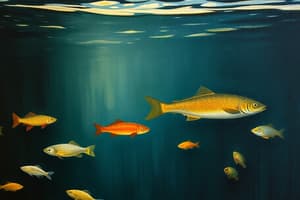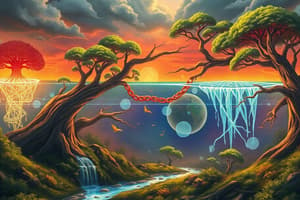Podcast
Questions and Answers
How does energy flow through ecosystems?
How does energy flow through ecosystems?
Energy flows through an ecosystem in a 1-way stream, from primary producers to various consumers.
What is a food chain?
What is a food chain?
A series of steps in which organisms transfer energy by eating and being eaten.
What are phytoplankton?
What are phytoplankton?
A mixture of floating algae that are some primary producers in some aquatic food chains.
What is a food web?
What is a food web?
What does it mean that energy flows in a '1-way stream' through an ecosystem?
What does it mean that energy flows in a '1-way stream' through an ecosystem?
What are zooplankton?
What are zooplankton?
What might happen to the Everglades ecosystem if there were a sudden decrease in the number of crayfish?
What might happen to the Everglades ecosystem if there were a sudden decrease in the number of crayfish?
What is a trophic level?
What is a trophic level?
What are ecological pyramids?
What are ecological pyramids?
What are the 3 types of ecological pyramids?
What are the 3 types of ecological pyramids?
What do the 3 types of ecological pyramids illustrate?
What do the 3 types of ecological pyramids illustrate?
What is biomass?
What is biomass?
On average, what proportion of the energy in an ecosystem is transferred from one trophic level to the next? Where does the rest of the energy go?
On average, what proportion of the energy in an ecosystem is transferred from one trophic level to the next? Where does the rest of the energy go?
If 100% of the energy is available at the first trophic level of an energy pyramid, what percentage of that energy is available at the highest trophic level?
If 100% of the energy is available at the first trophic level of an energy pyramid, what percentage of that energy is available at the highest trophic level?
Flashcards are hidden until you start studying
Study Notes
Energy Flow in Ecosystems
- Energy flows in a 1-way stream from primary producers to consumers, not cycling back.
- Primary producers convert light energy into chemical energy, serving as the foundation of food chains.
Food Chain and Food Web
- Food chain consists of a linear sequence where energy is transferred through various organisms eating one another.
- Food web represents a complex network of interconnected food chains, illustrating multiple feeding relationships.
Key Organisms
- Phytoplankton are floating algae that serve as primary producers in aquatic ecosystems, crucial for energy flow.
- Zooplankton are small, swimming animals that play significant roles in aquatic food chains as consumers.
Trophic Levels
- Trophic levels are defined as each step in a food chain or food web, illustrating energy transfer among organisms.
- Energy transfer from one trophic level to the next averages about 10%, with losses primarily as heat.
Ecological Pyramids
- Ecological pyramids display the distribution of energy, biomass, and numbers across trophic levels.
- Types of ecological pyramids include:
- Pyramid of energy: Shows energy availability at each level.
- Pyramid of biomass: Represents the total living organic matter at each level.
- Pyramid of numbers: Illustrates the count of organisms at each level.
Effect of Ecosystem Changes
- A sudden decrease in crayfish population in the Everglades would disrupt the food web, impacting various predators and the overall ecosystem balance.
Energy Availability at Trophic Levels
- If 100% of energy is at the first trophic level, only 0.01% remains at the highest trophic level due to energy loss at each stage.
Studying That Suits You
Use AI to generate personalized quizzes and flashcards to suit your learning preferences.




